Evaluating Shopify Apps, their Reviews, and the Developer
One of the secrets to creating a successful Shopify storefront is to utilize apps, add-on programs that provide additional functionality to Shopify sites. With the Shopify App Store, site owners can customize how an online store runs and how customers and users interact with it.
But it’s almost too easy to install and uninstall Shopify apps. Most apps offer free trials, so the financial risk on trying new things is limited. The real risk lies is in the additional code most Shopify apps add to a site’s theme. This can range from one line of code to extensive changes to a theme. And even if the app is uninstalled, tiny pieces of code may remain, littering the theme with potential landmines.
Case in point; a bakery in Washington State, installed a free app that created a pop-up warning when customers placed a hot beverage order after hours. After finding they couldn’t schedule the pop-up, they uninstalled it. The next morning they arrived at no online sales after being accustomed to dozens of early morning orders. It took a day to discover the root cause. It turns out the uninstalled app left a submit function tied to the “Add To Cart” button that interfered with another app.
A day of online sales was a small price to pay for two important lessons: 1) use a Shopify backup app like Rewind to get business back up and running, and 2) thoroughly evaluate an app before installing it. It’s easy to fall prey to a quick and cheap fix. The good news is that all the information needed to make good app choices can be found in the Shopify App Store.
A Shopify app’s pricing, description, reviews, and support documentation contain a trail of clues for what to expect from an app.
The Shopify App Price
The majority of Shopify merchants start out with limited budgets. This often puts people in the mindset of “what can I find for free” rather than “what is my budget?” Don’t get me wrong, there are great free apps out there. But the primary driver behind choosing an app should always be “does it solve my problem and not cause more work elsewhere?” Be honest with yourself. How much are you willing to pay for increased productivity, improved usability, better reporting, or whatever it is you are looking to do. Setting a budget upfront increases the number of Shopify apps you can choose from. In the end, if a free app serves your needs as well as a paid one, great! But settling for an app simply because it’s free will often cost you more money and time in the long run.

Get Rewind Backups for Shopify
Take, for example, one of my non-profit clients that uses a free forms app. It’s a fantastic app, but the information it gathers goes nowhere. They have to export and import the information every month into other systems. When they are running low on staff, this is the first task that gets set aside. As a result, their customer database is out of date, their marketing is less effective, and this results in lost sales.
Resisting the lure of a free app is a lesson every Shopify store owner learns over time. The sooner you learn it, the better.
The App Description
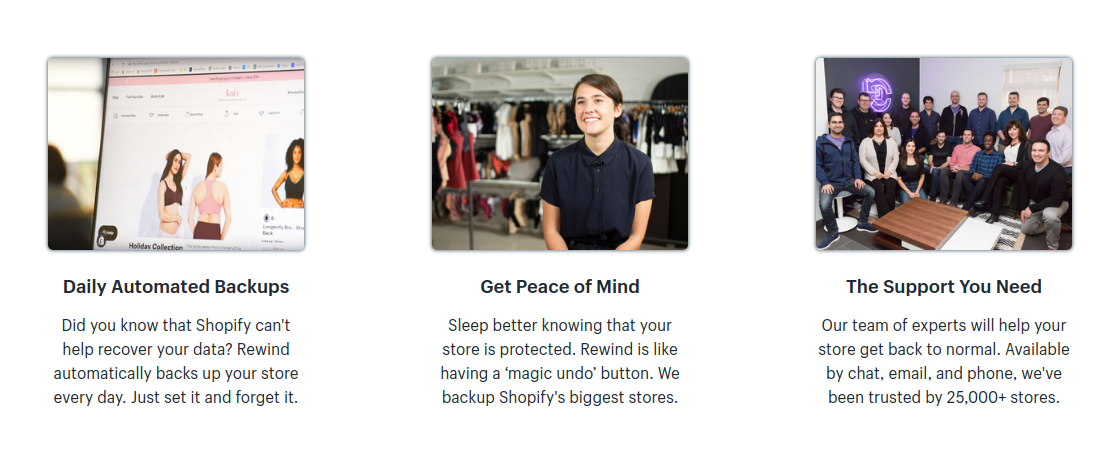
First of all, it’s important to understand that the app description, video, and screenshots posted in the Shopify app store are first and foremost marketing tools. They are created to ignite your interest in their product and are only pieces of the puzzle. Remember, you are not looking for a good marketer, you are looking for a good developer.
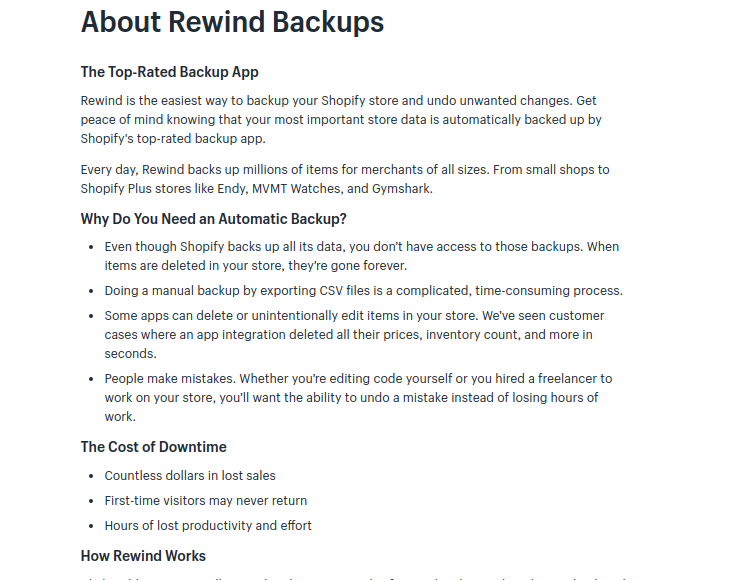
For example, a client downloaded a filtering app that advertised it supported metafields. Unable to find a way to use their custom fields, they contacted the app developer and learned metafield integration was an additional $150 fee. This app overpromised and underdelivered. On the other hand, a sticky button app they downloaded contained far more features than listed. It replaced three other apps they used, saving them time and money. This app underpromised and over-delivered.
So if the description alone may not accurately portray the app, how can we discover what’s missing? Reviews. Customer feedback fills in the missing pieces.
App Reviews
Product reviews leave the largest trail of clues if you know how to read them. The more reviews, the more clues. Of course, reviews are also a marketing tool, but in this case, the consumer plays a role in the messaging. Sure, an app with a strong marketing team will actively ask for reviews, but that means they’re confident they’ll get good reviews. It’s an incentive for everyone to do their best.
1-star and 2-star reviews
Read one-star reviews first but don’t invest too much time reading why the one-star review was left in the first place. These are usually a mix of genuine concerns and flat-out revenge. Entertaining, but not always helpful. Instead, look at how the company responds. This is the most tell-tale sign of how you can expect to be treated by this developer if you have a problem. Do they respond at all? Are they defensive? Do they explain how they fixed the problem?
For two-star reviews, read the actual review and developer responses carefully. Someone that takes time to leave a two-star review generally has a legitimate concern, but a level enough head to acknowledge the good and the bad. I look for common threads, such as a feature not working, and then I check to see the complaint goes away over time. Time is the keyword here. We all grow and improve as businesses and people over time. I hope to see the app developer use the review feedback to improve the app and its service. This shows me the developer is a long-term player in the Shopify app store and not someone who posts unsupported apps for a quick buck.
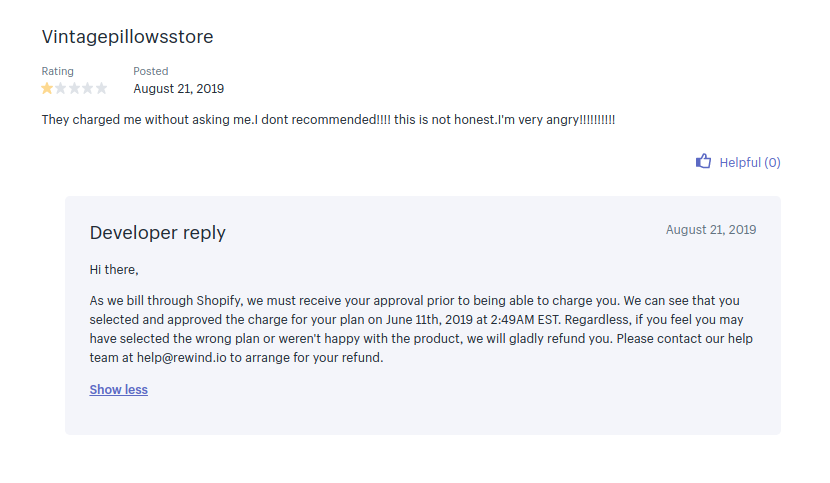
3-star reviews
Truthfully, I only skim three-star reviews. More often than not, three-star reviews are short but sweet. The store owner liked the app, but it didn’t meet their specific business needs. If anything, three-star reviews are most useful to app developers who can use the information to strengthen their app store descriptions to better align their customer’s expectations of the app.
4-star and 5-star reviews
By the time you read four and five-star reviews, you don’t need to be concerned about customer service. Someone who leaves a four or five-star review is usually happy enough with the customer service to leave the review in the first place. But if you are searching for features that might not be listed in the app description, this is where you can find them.
I usually have a specific problem I’m trying to solve when I search for a new app. Since the app’s description can’t speak to all use cases, four and five-star reviews are a good place to find other people who use the app in the way I intend to. Again, time plays a factor. You want to see new and improved features appear over time. This means the app will grow with you, making your time and financial commitment a good investment.
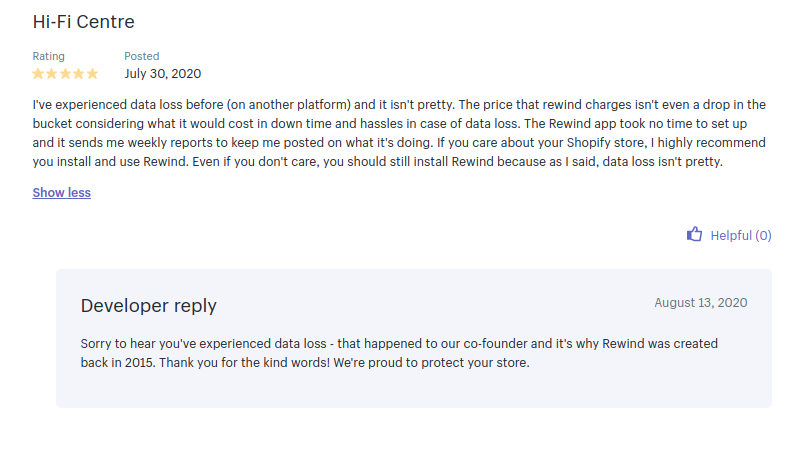
App Support
After reading reviews, head straight to the support listing. This section lists the developer’s FAQ, website, phone number, privacy policy, email, and support link. However, only the email and privacy policy are required by Shopify. If there is a strong FAQ, it can be the key to understanding an app. It gives you a glimpse of unadvertised features, the complexity of troubleshooting the app, and provides reassurance that you can solve many problems on your own.
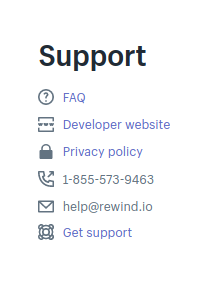 In lieu of an FAQ, some developers house support documentation on their website. The developer’s website gives you a hint at who the developer is. Are they a one-person shop out of their basement? Is it a large company with a suite of products? Why do they develop Shopify apps? Of course, anyone can hide behind a splashy website. But if a developer is willing to invest time and money in their site and brand, chances are, they put as much work into their apps, too.
In lieu of an FAQ, some developers house support documentation on their website. The developer’s website gives you a hint at who the developer is. Are they a one-person shop out of their basement? Is it a large company with a suite of products? Why do they develop Shopify apps? Of course, anyone can hide behind a splashy website. But if a developer is willing to invest time and money in their site and brand, chances are, they put as much work into their apps, too.
This brings me back to the basement developer. If you’ve done your due diligence and evaluated their app thoroughly, don’t be scared of small developers. Some of my favorite Shopify apps were young when I first used them. It gave me the opportunity to help drive new features and usability improvements. As a result, these apps are almost tailor-made for my clients. If you find a committed developer, and you’re willing to be patient as they ramp up their app, the long-term payoff is worth it.
You’ve reviewed the description, reviews, and support documentation and are convinced this app is for you. Now what?
Installing the App and Getting the Most from It
As I mentioned from the very start, installing an app is almost too easy. It’s important to understand what happens after selecting the “Add App” button.
Before installing the app, you will give the app permission to access your site. This can be scary if you actually read it, and I’m convinced it’s why most people just hit the install button and keep going. In most cases, you grant the app access to your orders, theme files, product details, and everything else that runs your shop. It’s a good idea to back up your Shopify files before proceeding. Backup apps like Rewind allow you to easily “turn back the clock” and restore your site to a time before you installed a troublesome app.
More importantly, in addition to site files, apps often seek permission to access customer records, the information you pledge to keep private. While all Shopify apps have a privacy policy listed, most policies are straight from a template provided by Shopify. But by now, you should have trust in the developer based on your research. If you don’t, step back and ask yourself why.
Next, when it applies, you will pick a payment plan that will activate after the free trial ends. Pay attention to this information carefully. Many plans have variable rates that change based on the number of customers, orders, or even their own system of credits. Understand the charges you are agreeing to before you continue so there are no costly surprises later.
Your app is now installed, or is it? Some apps require the developer to manually insert code. Hopefully, this isn’t a surprise to you. This should have been discovered during your app evaluation. If it wasn’t, be sure to note the app requires manual installation when you review the app later. This helps other store owners. There is nothing worse than trying to solve an urgent need and having to wait for the app to be installed.
Now your app is really installed and the fun begins. You’ve done your research and you’re now part of the family. And I don’t say that lightly. App developers are some of the most dedicated, kind, creative people I know. The secret to getting the most out of your app is simple. If you are respectful of their time and constraints, they will respect you back. Recognize you are a partner in the process. Reach out and say hi. Ask for help if you need it. If something doesn’t work, give them the chance to fix it. Request a new feature. You’d be surprised how many little tweaks developers will make so the app works for you. Be a good partner. After all, that’s what the “Shopify Community” is all about.
But sometimes, even after all of this work, an app doesn’t meet your needs. It’s time to uninstall the app. Before deleting the app, be sure to review the app’s documentation. The best Shopify apps will provide a detailed, step-by-step guide for how to uninstall the app. This includes removing those pesky lines of code we discussed earlier. If you don’t see an uninstall guide, reach out to the developer and ask. This is another opportunity to explore why the app is not working for you. More than once, I’ve had a developer move a planned feature to the top of the list to make the app work for a client.
But in the event you do uninstall the app, be sure to explain the reasons why in the pop-up comments box. This helps the developer better understand and improve their app, resulting in a stronger app for the entire Shopify community.
Regularly Evaluating and Reviewing your Shopify Apps
Setting up a new website can be a lengthy process. When you’re done, it’s easy to make a big sigh of relief and then promptly ignore the site. And while your hard work upfront should reward you with low maintenance, it’s important to regularly review your site.
You should have a checklist of website maintenance tasks, including confirming your theme is up to date, the content on your products and pages is correct and fresh, orders are archived and inactive products purged, incomplete customer records are updated, etc. Before doing your maintenance work, make sure you backup your data in case you make an unintentional deletion, something every store owner does at some point. Rewind makes it easy to restore a deleted product or page in a matter of minutes. But how do you manage your apps? This is often an overlooked part of website maintenance.

Review your list of Shopify apps. Are you using them all? Many times, store owners install an app to solve a short-term problem. Once that challenge passes, they forget to uninstall the app and continue paying the monthly fee. Uninstall unused apps using the method we discussed above.
After cleaning out obsolete apps, it’s time to look at each and every app. Re-evaluate the app using the same method you did when you first selected the app. Check the price, description, reviews, and support documentation. Look for price changes you were unaware of. Are there new features in the description? Make sure the rating has not gone down and look for potential problems in the reviews. Finally, check the developer’s website. Do they have any new apps?
This is a great time to consolidate Shopify apps to save money and reduce your risk. One app may have a new feature that duplicates the work of another app. Or your favorite developer has a new app that competes with one of your existing apps. Start fresh and reevaluate the two apps side by side and decide if you can delete one. However, just because they duplicate efforts, don’t feel forced to uninstall one.
One of my clients uses metafields extensively both to create extra fields on their product order pages and to store extra data about products, orders, and customers. They use two different metafield apps. One has a better customer view and the other a better administrative view. Both serve specific needs even though they do the same thing.
Now it’s time to shop. Make a list. Is one of your apps missing a desired feature? Can you automate time-consuming tasks? Do you want to make ordering easier for your customers?
Head back to the Shopify app store and evaluate new apps. If you consider replacing an app with a new one, make sure the risk is worth it. Remember, your site has been running well up to this point. Unless a new app is going to save you money, time, or is dramatically better in quality, consider if it’s worth the risk that it might not play well with your theme or other apps.
Also, consider doing an internet search for new Shopify apps. For security reasons, avoid downloading apps from outside the Shopify app store, but look to articles that lead you to apps that might be overlooked in the Shopify app store. App developers provide up to five search terms in their profiles when they post a new app. Sometimes, developers define their apps very differently than consumers. For example, my favorite product bundling app doesn’t even show up under the product bundling category. Why? It was a feature they added later and the developer likely didn’t update their listing or ran out of search terms.
This is also a good time to ask yourself if you have outgrown your apps. It’s easy to string together a half dozen apps to solve a problem. Stop and look at the time and money you are spending. Is it better to invest that money in a developer who can build a long-term solution? There are many great developers out there who can help you work within a budget, don’t neglect this option as you evaluate apps.
Finally, make sure you leave reviews for all the apps you use and change any reviews you feel need to be updated. Don’t be shy about word count. Share what you love and don’t love about the app, what features you use, and any interaction with the developer. By becoming part of the process, you make the Shopify App Store and community stronger.
10 Best Shopify Apps for 2022
We’ve put together a list of 10 of the best Shopify apps for 2022. These apps can help you manage your business, increase sales, and promote your website.
1. Jebbit
Jebbit is able to make the user experience more interactive by enabling ecommerce store owners to create visually-appealing quizzes for visitors in order to match them with a product. This can lead to a stronger customer experience and a higher conversion rate.
It measures engagement, completion, lead rates, and other factors that can provide insight into your customers’ behavior. It can also be used for personality quizzes or other simple polls. There are many possibilities for increased engagement with Jebbit’s features, making it one of the best Shopify apps on the market today.
2. Bold Product Options
Bold Product Options provides an intelligent shopping caddy that customizes the product selection process for your customers. It allows customers to create variations of a product (e.g., adding custom designs, logos, etc.) and then add those variations to their cart with a single click.
This app truly offers almost any option imaginable when it comes to custom products. It’s perfect for a Shopify store that sells products with multiple options, and it can help increase sales by making the buying process simpler and more personalized for your customers.
3. UFE Cross Sell & Upsell Bundle
The UFE Cross Sell & Upsell Bundle helps shop owners increase sales by providing personalized recommendations at checkout and across the website. You can develop custom product bundles to upsell and add a time limit to the offer with a countdown appearing to your customer.
For added insight, the app can create a report demonstrating the performance of these bundles. It’s a lightweight app that can improve your customer’s journey without the weight of a heavy script overtaking your theme.
4. SendOwl
SendOwl helps shop owners sell digital products with ease and offers the ability to send automatic, time-sensitive download links to customers. These download links are sent from a network of reliable servers across the world. It can also automate ‘drip’ sales, which are sent over time and not all at once. Part of SendOwl’s appeal is their full-time team committed to providing high-quality service to app users.
SendOwl is perfect for businesses that want to sell ebooks, software, or any other type of digital product.
5. Order Printer
Order Printer can help you print packing slips, invoices, recipes, and labels for your Shopify orders. Integration with Shopify Shopping makes it easy to print professional-looking documents, saving you time and hassle.
It can print one at a time or in bulk, depending on your needs. It’s a simple and free app great for anyone looking to get organized or add a professional touch to their documents.
6. Shipstation
Shipstation is a powerful shipping app that helps you automate your shipping process. It integrates with over 200 shopping tools/services (such as fulfillment services, marketplaces, and more) so you can ship your products quickly and easily. They also work with over 50 trusted carriers worldwide.
This app is perfect for businesses that want to streamline their shipping process. And for those looking to scale, the app can help you do just that by keeping all your orders in one place.
7. Instafeed Instagram Feed/Story
If you’re looking for a way to promote your Instagram feed on your Shopify store, the Instafeed Instagram Feed/Story app is a great option. The app lets you showcase your latest images and videos on your Shopify store by creating a storyboard that displays on your home page.
With social proof being a large factor in many customers’ purchasing decisions, having photos and videos that support your brand can help engage customers that visit your website.
8. Mailchimp
As many online business owners know, email marketing can be a great way to build up a base of loyal customers. Mailchimp s one of the best email marketing apps out there – it lets you engage customers on autopilot by sending personalized emails to your subscribers.
You’ll be able to use features to help drive higher conversion rates and repeat purchases. You’ll also gain insight into your store’s ROI and have the ability to recommend products to customers based on their previous purchases.
9. AfterShip Order Tracking & SMS
AfterShip lets you track all of your shipments and deliveries in one place by automatically adding all your tracking information into the app, eliminating the need to track orders manually. Plus, customers receive an automatic email when orders are delivered. By utilizing this app, you also get insights into whether your orders are experiencing delays. It’s a great tool for streamlining the shipping process for your store.
10. Rewind Backups
Our very own top-rated Shopify app, Rewind Backups, automatically backs up your online store on a daily basis. It backs up products, customers, blogs, pages, policies, gift cards, and much more. You’ll receive a weekly summary email that keeps you up to date with your backups. And if you do lose data, you can restore your entire store or certain items in just a few minutes, avoiding lost revenue and disappointed customers. We even offer a free 7-day trial to get you started.
Protect Your Shopify Store with Rewind
Before installing any new apps, it’s always a good idea to have a solid backup strategy in place in case something goes wrong. Rewind Backups for Shopify automatically backs up your store’s data, and allows you to restore anything from a single product to your entire theme. Rewind’s suite of data protection apps helps over 100,000 businesses secure their cloud data.
Melissa Cable is a marketing consultant and serial volunteer for non-profits and small businesses that need website services that go beyond their outward presence. She holds an MBA from the University of Washington and has served in marketing positions in the fine dining, wine, publishing, and retail industries.